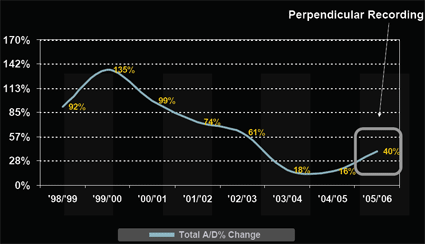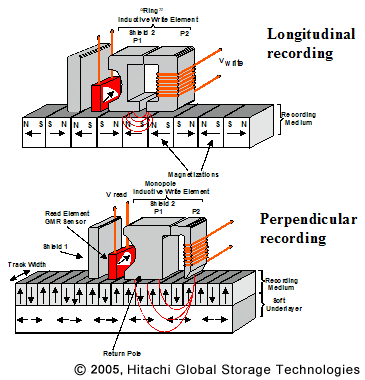Round-Up: Comparison Testing of 22 Hard Disk Drives
A Stagnant Market?

Thanks to perpendicular recording (vertical magnetization for storage of individual data bits), data densities are expected to increase quickly (source: Seagate).
We believe it's a given that the hard disk industry must be judged at this point. Anybody who's been following the development of hard disks over the past few years has surely determined that neither real breakthroughs nor significant technology advances have occurred of late.
Drive rotation speeds have stagnated at 7,200 RPM, except for WD's Raptor; as a result, performance improvements in the past two years have been meager. Even capacity increases stalled for a long while following the introduction of 250 GB drives. Hitachi pushed that ceiling higher, first with its 400 GB and now with 500 GB drives, but this latter increase came about only by using five platters rather than the more customary four.
In 2002, somebody with a two-year-old hard disk could improve both capacity and performance noticeably by replacing the old drive with a new one. Today, swapping a two-year-old model for a current drive will probably increase overall capacity, but it won't improve performance much, if at all.
The Future Is Coming: Perpendicular Recording
Storage of individual data elements occurs through the magnetization of tiny domains on the drive platter, organized into fixed-size data sectors on concentric tracks that radiate inward from a drive's outer edge. The orientation of individual storage domains had always been horizontal - that is, across the drive platter, parallel to its surface.
The continued miniaturization of hard disk storage domains has led to the "super paramagnetic effect," where individual magnetic storage elements influence neighboring ones, and can even reverse their polarity in some situations. This results in irrecoverable corruption and loss of data previously stored.
This issue has led to a limit in how densely data can be packed on hard drives. However, that barrier will be lifted in 2006, with the introduction of a vertical recording technology called perpendicular recording. As the name indicates, this changes grain orientation to make it perpendicular to the platter's surface, and enables significant increases in data density in the near term. By 2007, Hitachi predicts that it will have 3.5" drives with total capacity of 1 TB and 1" MicroDrives that hold 20 GB.
Stay on the Cutting Edge
Join the experts who read Tom's Hardware for the inside track on enthusiast PC tech news — and have for over 25 years. We'll send breaking news and in-depth reviews of CPUs, GPUs, AI, maker hardware and more straight to your inbox.


Most Popular

